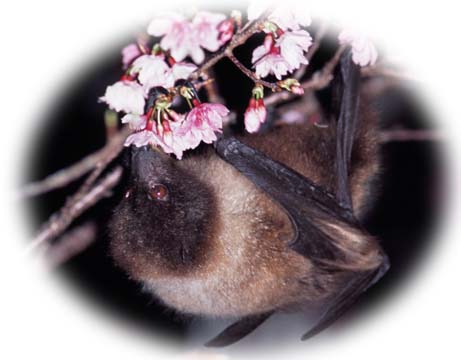
Go to the Japanese Version
Fruit Bats
Other Bats
Other Wildlife
@Australia
@Christmas Island
@United States of America
@Other Countries
Bats in all ages and cultures
About us
Other web pages of us
Welcome to the fruit bat world
Our blog (in Japanese)
Some travel records are here
Bat travel across the world
|
Fruit Bat Photo Library
by Yushi Osawa & Keiko Osawa

It was about 35 years ago that we encountered fruit bats on Minami-daito
Island in Okinawa prefecture for the first time. That encounter led us
to fall in love with fruit bats. They have captured our hearts and minds
with large eyes and fluffy fur. We visited many islands in Okinawa and
Kagoshima and the Ogasawara islands to take pictures of all species and
subspecies of fruit bats in Japan.
We have also traveled overseas to see fruit bats. In Australia we saw ten
thousands fruit bats flying out at dusk. In American Samoa we saw fruit bats
soaring during the day against the blue sky.
There are 186 species of fruit bats in 42 genera. Because many of them
live in Africa and South East Asia there are often difficulties in traveling
to see them. But we are going to keep up our trips. We also want to see
fruit bats in the family Phyllostomidae in Central and South America. In
total, our target is 263 herbivorous bats. And we also look for as many
other types of wildlife as
possible.
All rights reserved
Copyright 2002-2023 Yushi Osawa HJPI320810000971
If you want to use the pictures on these web pages email us

|

At the end of December 1988 we first encountered flying foxes on Minami-daito-jima
Island. Since then we have traveled to all the islands that flying foxes
inhabit in Japan, which includes that Kuchinoerabu-jima and islands south
of it and the Ogasawara Islands to see and photograph the bats. We have
also traveled overseas to find different species of bats.
We had enjoyed awesome wildlife and had become engrossed in the amazing displays of nature but we came to realize that there was a long list of scenes that we would never be able to view as long as we were employed as ordinary workers, working 5 or 6 days a week and having holidays only on weekends, New Year, Christmas, Golden week and about ten days in summer.
For example we have had chances to visit Maine in the US several times in summer. Summer in Maine is lovely with lots of wild flowers, blueberries to pick, moose and beavers to see but we had never been able to see the autumn leaves or the new green leaves of sugar maples.
One of our friends who retired visited an area of Canada which is not far from Maine at the height of the fall foliage and witnessed fantastic golden yellows, tawny ambers and deep reds with splashes of forest green while traveling several hours by bus. In Japan there are four seasons but the severity of the winter in Maine and Canada must make the season more distinct and beautiful.
Vivid tropical jungles in everlasting summer are also enticing with bright colored birds and perfumed flowers. But it seemed that no sooner had we found the elusive flying foxes, it was time to go back to Japan. Deserts are also interesting considering how wildlife can survive with only several days of rain a year but are hard to access on a short trip.
Everytime we looked at tour brochures and tour advertisements we were amazed how incredibly cheap the accomodations and flights could have been if we had traveled during low seasons. We knew we would never be able to travel in low seasons at this rate.
It is everyone's obligation to fulfill the responsibilities of adult life. First of all, we need money to travel whereever it is we want to view wildlife, to buy whatever wildlife books we want to read, to buy camera equipment and to lead a moderately comfortable life. But at the same time our work deprives us of time to read and write books, and enjoy nature. A Catch-22
If we had been able to take a one year unpaid sabbatical every 10 years
we could have had a balanced life and might have continued my previous
job.
It was time for us to turn a page in our life. We decided to quit our previous
jobs in March, 2006 to dedicate ourselves to bat watching and photograph
while we are still strong enough physically to carry equipment and chase
after wild animals in their natural environments.
There are 1462 species of bats recorded across the world. Bats inhabit
in all regions other than the Antarctic Continent and the Arctic. Their
roosts and food habits are diversified. Their life is not enough investigated
due to the lack of bat researchers. It is that diverseness, not being enough
investigated and gap between images of unfounded fears and superstition
and adorable true bat which keep these animals compelling.


![]()
